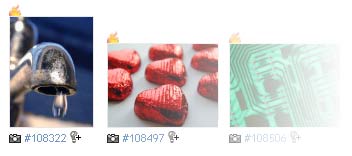I've written previously and read over-and-over on various blogs regarding analysing and measuring what sells on microstock, but recently it struck me that I've never explained exactly what I mean when I say "analyse your sales"
Sales Analysis of stock photos can be broken into three important parts:
- The Microstock Marketplace
- Other Photographers
- Your Previous Sales
Analyse the Marketplace
Microstock, by its nature has become all things to (almost) all photographers. Knowing what is the most popular subject is by no means a way to get the most sales. Most stock photo creators specialise in one or more genres, food, people, 3d, illustrations etc. Microstock images tend to have a few differences to those from macrostock agencies. Learning a few general rules about what works in microstock or your genre is important. A typical example would be copyspace, in microstock it seems that large central images that look good as thumbnails work better even though they are less useful to a designer wanting space for text.
For me, analysing the current photo market is a 'loose' look around the web gleaning little bits of information here and there rather than any sort of structured analysis. It's the type of thing that stock photographers do almost without thinking. If I happen across a photographer's microstock profile while I'm browsing I often look at their best sellers and more frequently at the images they have which didn't sell (often more revealing). As a microstock contributor you have access to all the tools needed, most agencies send out newsletters which include popular or recent images, either hand picked or automatically selected from their website.
A look at shutterstock top searches or pixmac top searches - is interesting, as is looking at their most popular sales and comparing with and most popular in the past week, but be careful looking at lists of top sellers, there are almost always pictures of flowers and cloudy blue skies in there. These subjects are completely saturated in microstock and either way are unlikely to match the style of photos you take. It's possible you could go out and try to emulate the 'top sellers', that might even be a good learning experience for a beginner, but it's not a serious way to make decisions about future photo shoots, you never win by following the leader
What are other Photographers Doing?
istockcharts (via microstocktime) is a marvellous little tool which tracks (all?) 30000 istock photographers in order of the number of downloads they have received. You can search to find your own rank amongst other photographers, check out who's uploaded in the past 30 days, see who's been on istock the longest, sorted by number of files each photographer has etc. A wealth of info to be seen, the site is most useful for getting a broad understanding of the range of photos available - you will see the top photographers all shoot different styles of work, each is working well for them, some profiles only include 3d renders, some focus on group shots, some on individual people etc.
Below is a list of movers and shakers in the industry (aka the microstock celebrities) whose diverse istock profiles you can have a look through:
Kelly Cline (food photos)
Yuri Arcurs (happy smiley people)
Sean Locke (happy smiley people doing stuff)
Andreas Rodriguez (composite images)
Kirsty Pargeter (illustrations)
Andrew Johnson (rendered images)
If you find a photographer who is shooting the same style of images as you then feel free to contact them, one of the many nice things about microstock is the openness to sharing of information that most photographers embrace (that sharing and helping usually works both ways). You will also see that most profiles link to a business website, and many of the top photographers have twitter accounts or blogs that you can follow or subscribe to. I find all this web 2.0 technology makes it very easy to 'loosely follow' what other people are doing, the 'background hum' of messages/feeds/posts that I see each day allows me to keep tabs on what's happening in the industry and the various directions that photographers are 'flocking', what's more important is that if I'm busy (always!?) I can just ignore this information or control exactly how much attention it receives.
Are your images selling?
Analysing what other people are selling is all well and nice, but you also need to see which of your images are selling. In doing so you can concentrate on which style of images that you take are being most profitable for you. e.g. it's nice to see that images of Christmas trees and flowers are some of the biggest sellers, but if you specialise in food photos then you need to analyse which style of your own work sells best, e.g. isolated food objects, health food, high-key / white backdrop, natural/rustic still life of plated food etc.
To do this you need to do a little better than looking at which of your istock images have flames on them...

Sorting your profile by downloads gives you a view of what sold well in the past as well as what is selling now. To analyse more deeply you need to look at what sold recently say within the past 30 days, at some microstock sites you can look through the stats of each sale to get a rough idea of your sales, or export them for analysis in a spreadsheet. Lookstat was one way of analysing sales, the service is free, but unfortunately (as of Jul 2009) Lookstat analytics is not being further developed so it's limited to checking just 2 websites, istock and dreamstime.
Look for trends in sales not individual best sellers, this is where you lose out by copying what’s already in the marketplace, you might be looking at the ‘wake from a boat that you have already missed’. By looking at trending information you might notice that a certain style of your work is growing in sales. We have seen all sorts of trends over the past few years in both image style and subject material. Microstock best sellers continue to be somewhat different to those that would traditionally be considered good stock photos.
Take care not to extrapolate too much about what may be just a random burst of sales. As you probably know, if you look at your stats and see you have earned say 4 dollars yesterday it’s a very big step to assume that you will earn 120 dollars over the whole month. Make sure that you don’t “amplify error” when looking at stats, good sales from a certain group of photos might indicate one of several things, including good keywords or descriptions, their use in a lightbox or search engine traffic as well as the actual choice of subject the image depicts. Don’t assume that for example if your images isolated on white are selling well it means that all images on white will sell, you could be overlooking the fact that all of those images are also say technology subjects, and in fact it’s that which is the selling point.
Other useful analysis tools
 istock zeitgeist - Listing of the rise and fall in popularity of istocks biggest selling images along with upcoming photographers. You can also have a look at the top 15 downloads over the past 3 months, month or week at istocks most popular.
istock zeitgeist - Listing of the rise and fall in popularity of istocks biggest selling images along with upcoming photographers. You can also have a look at the top 15 downloads over the past 3 months, month or week at istocks most popular.
Picniche is a website (from the makers of the picniche toolbar) that draws a comparison between the amount of times a keyword is searched for and the number of images on offer. You can use picniche to discover if a subject you are planning to shoot already has a lot of supply compared to the number of times it's searched for. This again highlights that it's not always the most popular subjects that make the most sales, less common searches can have less competition too.
Monitor Trends
If your work tends to cover a specific topic then make sure you stay up to date with current jargon and buzzwords. Subscribe to industry newsletters rss feeds etc. and 'float over' them as background info on what's new. To be ahead of the game you'll already have images that feature say 'social networks' or 'micro blogging' before the bulk of buyers and editors start looking for those images. While those two example topics are now starting to be covered you should be looking for the next big thing in your industry and looking to see if there are gaps in supply. Even if you don't specialise in a niche then looking at new trends in general can be a source of inspiration when things dry up. If you are doing things properly you will never be without a list of 'keywords' that need covering.
What do I do?
Well for me all this bean counting can get a little overwhelming, I'd rather concentrate on taking photos and uploading them. That said I do keep a close eye on what's going on - I just don't spend hours compiling and measuring data (some do and if you enjoy making a good spreadsheet then that's for you). For me it's a "gut feeling" and that's something I only learned through several years of experience looking at not just my sales and microstock sites but stock photos in general, magazines and media, design websites etc. Even those throwaways from BigW are something you can digest to get a feel of what people are buying and making use of.
You could argue either way that you need to disconnect your photography passion and personal taste from this analysis. I prefer to see how I can fit the style of work I like into what I do, and for me that's not just microstock but a 'bigger picture' (excuse the pun). Whatever your photography style I hope I've provided a few pointers and some useful tools you can use to better understand what's happening in the microstock industry.
Related Posts
What kind of images sell best?
Most popular microstock keywords (shutterstock)
Links to Microstock Blogs and Related Sites



It's quiet in here! Add new comment